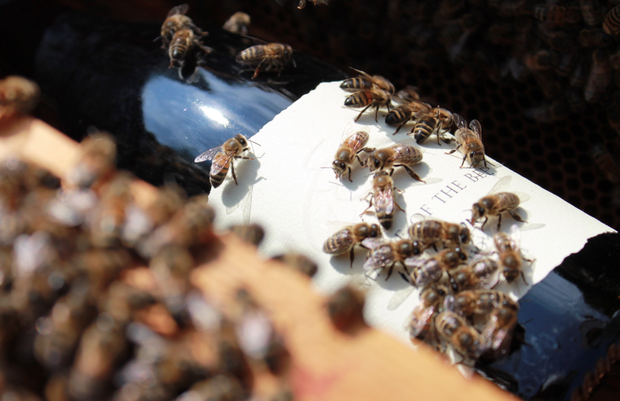
French winery fits mini cameras to bees to pioneer new viticiulture breakthrough
In a groundbreaking trial a French-based wine producer has developed a technique that could revolutionise grape-growing and have spin-offs for how we all see the world in the future.
 Bees are being fitted with micro cameras to help map and transmit data from the vineyard
Bees are being fitted with micro cameras to help map and transmit data from the vineyard
Domaine of the Bee, a producer of award-winning reds in a rugged corner of Southern France, has been experimenting with fitting tiny cameras to bees that buzz around its vineyards.
When the bees are within range of the wi-fi enabled hive, data is transmitted back from each insect on a real-time basis. The software - based on the same principle that Google uses to produce Streetview - stitches together the footage from thousands of individual bees to produce a seamless 3D picture of the land up to 7 kilometres of the hive.
"We developed this as a way to monitor our ripening grapes, and to give us a daily report on the health of the vines - and it does that wonderfully well. Using the daily download, backed-up from the hive computer to the internet every night, I can fly 'virtually' around my vineyard, visiting individual vines," said Justin Howard Sneyd, owner of Domaine of the Bee.
"What we didn't realise, however, is the sheer quality of the images we would obtain and how much we learned about the area around our vineyards."
He added: "We have learned how the bees love the rosemary bushes that surround our vineyard, and we also have lots of footage of the neighbour's window-boxes, and even tantalising glimpses through their bedroom windows."
Bee-keeper Neil Tully MW was unsure at first how his bees would take to this work, and whether it would compromise the quality of the honey collected. He told Harpers.co.uk: "The trick is knowing how to glue the tiny cameras - about the size and weight of a small grain of rice to the back of the head of a worker bee, behind the three ocelli eyes, so that it can go about its business without encumbrance."

|
"Bees are the perfect candidate for this kind of work, as they live together in a hive, the bees rarely stray more than 2-3 kilometres from the hive in search of food, and humans have a long history of managing swarms safely."
Foraging workers cover a wide range every day, and most days we end up with a near-perfect 3D map in a 360 degree circle for 800-1,000 metres around the hive.
"The only time this doesn't work so well is when it is windy, as it often is in the Roussillon, when the bees get blown around, the footage is shaky, and we don't get much of a view of what is happening upwind of the hive," said Howard-Sneyd.
Tully and Howard-Sneyd's experiments have already sparked interest from technology companies in Silicon Valley, California and from military surveillance contractors. Google is also rumoured to be interested in acquiring the technology to power ever more detailed maps for Google Earth.
 The new technology has been patented as i-Swarm
The new technology has been patented as i-Swarm
Howard-Sneyd added: "The possibilities of this imaging technology (now trademarked as i-SWARMTM) are almost endless, and who knows what the spinoffs might be - we know that cockroaches are already being used to produce images of sewers, so it is a logical step to use bees to do the same thing above ground. For now, we are focused on using the information we collect to help our vines grow better grapes, so that we can make tastier wine."
Domaine of the Bee's wines have been widely praised by leading wine writers and can be bought in the UK on its website for £25 a bottle





